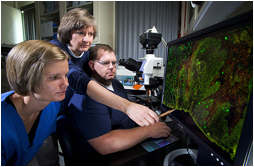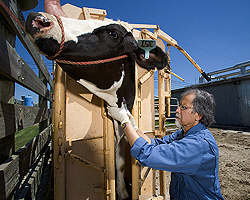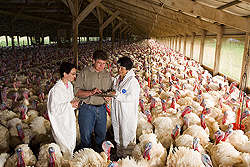



Keeping Meat and Poultry Safe
The Agricultural Research Service (ARS) is the principal in-house research agency of the U.S. Department of Agriculture (USDA). It is one of the four component agencies of the Research, Education, and Economics (REE) mission area. Microbiologist Evelyn Nystrom (center) indicates to technicians Briony Lachinski and Bryan Wheeler the fluorescent-stained lymphocytes in rectal tissues obtained from a calf experimentally infected with E. coli O157:H7 bacteria. |
The unit—part of ARS’s National Animal Disease Center (NADC) in Ames, Iowa—continues to break new ground in protecting consumers against Salmonella, Escherichia coli, Campylobacter, and other harmful foodborne bacteria.
“The key to food safety is to keep potential foodborne diseases out of the animals, either through vaccination or separation,” says NADC physiologist Ronald L. Horst. “But equally important is detecting and eliminating microbes in food that can make people sick. It’s in this area that the unit repeatedly shows its value.”
Achievements and Challenges
The unit is one of five that make up NADC, the nation’s largest federal center devoted to animal-disease studies. Its recent achievements include development—by microbiologists Mark Rasmussen and Tom Casey and Iowa State University (ISU) researchers—of light-based scanners for inspecting beef carcasses for microbial contamination from fecal matter.And veterinary medical officer Steven Carlson and colleagues were first to document strengthening of disease-causing bacteria from interaction with protozoa inside ruminant animals. This research, during which an antibiotic-resistant strain of Salmonella became especially virulent while inside rumen protozoa, suggests that naturally occurring, digestive-tract protozoa may be a place where dangerous bacteria can hide and develop.
“We’ve had our successes,” says Rasmussen, “but there are aspects of our work—such as microbes that ceaselessly develop resistance to antibiotics—that ensure that the job will never be totally finished.”
The unit’s scientists have made important new findings while following up on research regarding protozoal behavior, microbial response to antibiotics, and the hiding places inside cattle of a particularly nasty bacterial strain of E. coli. And scientists studying the spread of Salmonella, Campylobacter, and other bacteria among animals are making breakthroughs thanks to new methods and technologies.
 Veterinary medical officer Amirali Hamir draws a blood sample to be tested for prion diseases. |
Microbes That Resist
Two recent studies have led to big findings on an important emerging food-safety and animal-health issue: microbial resistance to antibiotics.In one, microbiologist Thad Stanton and his team found that normal, commensal bacteria in the swine intestinal tract are not only reservoirs for microbial resistance, but are also, possibly, places where this resistance evolves.
Commensal bacteria feed off their hosts without harming them. Some offer protection from infection by interacting with the host’s immune system, while others directly benefit the host by digesting feedstuffs and providing nutrients.
“One bacterium in particular, Megasphaera elsdenii, showed extremely high levels of resistance to chlortetracycline, an antibiotic used to treat a variety of infections,” says Stanton. He adds that the importance of M. elsdenii in the intestinal tract has spurred him to consider using the bacterium as a barometer species to evaluate management strategies and efforts aimed at reducing resistance among intestinal bacteria.
Meanwhile, Carlson has become the first scientist to document rumen protozoa’s role in the transfer of antibiotic resistance within the bovine stomach. He and colleagues identified and described the transfer of resistance to ceftriaxone—an antibiotic used to treat pneumonia—from gastrointestinal tract bacteria known as Klebsiella to rumen-dwelling Salmonella that are sensitive to the antibiotic.
“Genetic exchange in the rumen appears to depend on different bacteria’s ability to withstand protozoal digestion,” says Carlson.
 Molecular microbiologists Alexandra Scupham (left) and Irene Wesley discuss modern turkey-production practices with farm co-owner Noel Thompson. |
Battling Nasty Bacteria
Other unit scientists are focused on defeating enterohemorrhagic E. coli O157:H7, the most common infectious cause of bloody diarrhea in people in the United States. Hemolytic uremic syndrome, a potential consequence of infection, is the main cause of acute kidney failure in U.S. children and can lead to lifelong disturbances of the central nervous system.ARS microbiologist Evelyn Dean-Nystrom and pathologist Joachim Pohlenz (now deceased) of the School of Veterinary Medicine in Hanover, Germany, discovered a new hiding place in calves where these dangerous bacteria hide: the rectal-anal junction.
“Specifically, we found the bacteria attached to squamous epithelial cells at the junction, which is a transitional zone containing a mixture of different cell types,” says Nystrom. “We found the bacteria there in more than 80 percent of the calves studied.”
Nystrom explains that detecting O157:H7 in cattle, which are the main source of strains associated with human disease, is difficult because the bacteria rarely cause easily discernible effects.
She says that to her knowledge, she and Pohlenz were the first to describe O157:H7 attachment to squamous epithelial cells at this site.
Previously, Nystrom and NADC veterinary medical officer William Stoffregen discovered that E. coli O157:H7 bacteria can be found in calves’ gall bladders as well as in the intestines. She’s currently collaborating with the Uniformed Services University of the Health Sciences in Maryland to develop an oral vaccine to reduce O157:H7 infections in cattle.
Meanwhile, research by Casey and microbiologist Vijay Sharma aimed at eliminating O157:H7 in cattle has led them to use reporter assays to identify mechanisms and genes that control the bacteria’s ability to colonize and persist in bovine intestine.
Reporter genes help monitor expression of other genes. “In this case, expression of a reporter gene is much easier to detect than that of the genes that E. coli O157:H7 needs for colonization and persistence in cattle,” says Casey.
Sharma used this technology to identify a key regulatory gene, called hha, which influences expression of other genes that are critical for O157:H7 colonization. “This has led to construction of specific mutant O157 strains that are currently being tested as vaccines to reduce or eliminate colonization and persistence in cattle,” says Sharma.
The Tiny Details
In other work, microbiologist Shawn Bearson and colleagues are using cutting-edge microarray technology and other state-of-the-art techniques to take research on Salmonella in pigs to a smaller level—a molecular one. Microarrays are microscope slides containing bacterial or host DNA that make it possible to examine thousands of genes in a single experiment.Bearson says she, immunogeneticist Joan K. Lunney of ARS’s Animal Parasitic Diseases Research Unit in Beltsville, Maryland, and ISU geneticist Christopher Tuggle want to identify the basis for swine’s resistance to colonization by S. enterica serovar Typhimurium by characterizing aspects of the animal’s immunity to infection. “Ultimately, we want to produce a genetic profile of the Salmonella-carrier pig,” she says.
Bearson says this will decrease preharvest disease and perhaps lead to diagnostic tests for resistance. “The research will also help the pork industry in breeder pig selection and will help control reemergence of Salmonella on the farm and during transportation and marketing.”
Stressing the Stresses
Transport and marketing stresses also concern molecular microbiologist Irene Wesley, who studies the roles of ecology and the surrounding environment in the spread of harmful microbes. “Attention must be paid to potential points of entry of these pathogens,” she says. “With turkeys, you have the hatchery, brooder, grow-out, and, finally, transport and marketing stages.”In one previous NADC/ISU study, Salmonella infection in hogs, which generally ranges from 4 to 7 percent on the farm, shot up to nearly 40 percent after pigs spent just a few hours in preslaughter holding pens.
Wesley is now conducting similar work, with ISU researchers, aimed at curbing Campylobacter on turkeys. “We’re examining whether events such as catching, crating, live-haul, and holding at the slaughterhouse affect microbe levels in market-weight birds,” she says. These events seem to alter the dynamics of Campylobacter in turkeys, mainly causing a switch in the prevalence of the bacteria C. jejuni and C. coli, she says.
“On a wider scope, we want to determine transmission-risk factors by correlating on-farm management practices with the presence of foodborne pathogens in livestock,” Wesley adds.
Exclusionary Work
Other breakthroughs regarding Campylobacter are on the horizon, through research by molecular microbiologist Alexandra Scupham and colleagues using competitive exclusion.Competitive exclusion is a beneficial intestinal bacterium’s protective effect that limits colonization by some bacterial pathogens. “This method has been applied toward protecting chickens from colonization by Salmonella,” Scupham says. “Now we’re focused on excluding Campylobacter from turkeys.”
Her team is using an advanced, array-based method called “OFRG”—for “oligonucleotide fingerprinting of rRNA genes”—to identify microbes involved in competitive exclusion of Campylobacter from poultry. “OFRG allows us to describe turkeys’ intestinal microbial communities in detail,” says Scupham. “And it’s the only array-based method capable of identifying previously undescribed microbes.”
She’s also using a DNA fingerprint method called “ARISA”—for “automated ribosomal intergenic spacer analysis”—to detect changes in intestinal microbial communities.
This team’s methods are part of an overall strategy to assess intestinal microbial flora dynamics throughout hog and turkey production. They’re using an emerging technology known as “molecular microbial ecology,” which involves identifying and tracking microbes associated with gut colonization by foodborne pathogens.—By Luis Pons, Agricultural Research Service Information Staff.
October 2006


